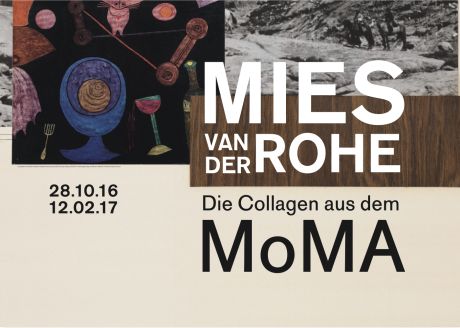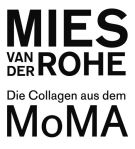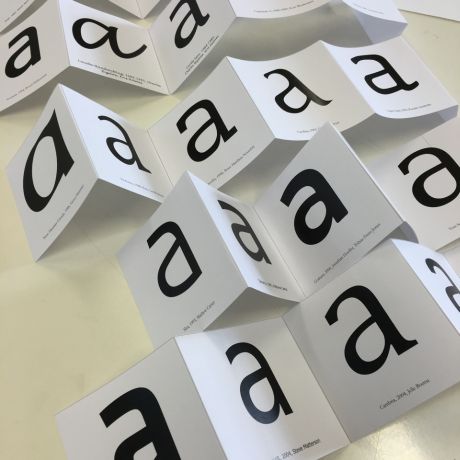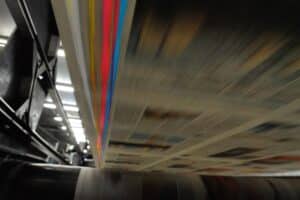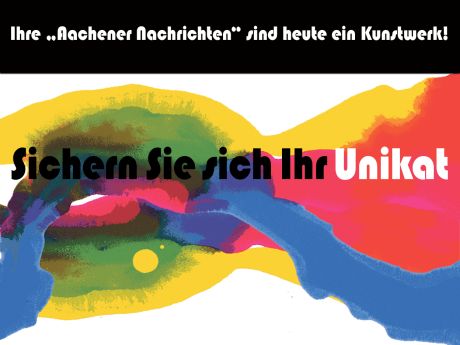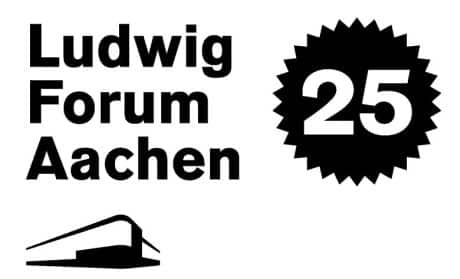Ludwig Mies van der Rohe (1886–1969), one of the 20th century’s most important architects, created numerous montages and collages between 1910 and 1965 that are fascinating illustrations of the design principles of his architecture. These works, most of them large-format, are far more than merely sketches that accompanied his creative process as an architect. They are works of art in their own right that show Mies van der Rohe’s structural vision in its purest form. Now the Ludwig Forum Aachen has organized a first-time exhibition of this amount of collages, set in the context of modern and contemporary art and featuring about 50 loans from New York’s MoMA, the Museum of Modern Art.
Like almost no other visual art technique, collage and photomontage reflect the aesthetic principles, the zeitgeist, and the attitude to life of Modernism. At the beginning of the 20th century, war, revolution and industrialization caused a shift in the way the modern world and progress were experienced and perceived, a shift that found expression in equal measure in newspapers and magazines, in visual and performing arts. Collage and photomontage were also soon being used in architecture. Influenced by Dada, Constructivism, and De Stijl, Mies van der Rohe exploited these new techniques – to a far greater extent than most of his contemporaries – to visualize his creative ideas on “New Building” (Neues Bauen).
Mies’s use of abrupt changes of viewpoint, freedom from perspective, place and time, montage of found elements and an aesthetic focus on mixed media places him in the same historical context as artists and experimental filmmakers like Kurt Schwitters, Theo van Doesburg, Hans Richter, and Laszlo Moholy-Nagy, to name but a few of the protagonists of the artistic avant-garde of that period, who contextualize Mies’s works in the exhibition.
The timeframe covered by the exhibition stretches from a first design draft for a proposed Bismarck Monument on the Rhine (1910) which was submitted jointly by Ludwig Mies van der Rohe and his brother Ewald Mies, through his visionary projects for Glass Skyscrapers in Berlin (1922), and activities in the USA from 1937/38 to his later works, like the design for the New National Gallery in Berlin from the 1960s. On the one hand, the presentation of the works follows a chronology of Mies’s designs and projects, on the other hand it explores the historical and artistic context. Special attention is paid to the fluid boundaries between fine art and architecture. In all his collages, Mies used reproductions of works by artists he was friends with, he highly appreciated, whose works he partially actually collected himself, and who obviously had special significance in terms of his aesthetics. Especially he chose to integrate into his collages works by Paul Klee, Wilhelm Lehmbruck, Georges Braque, and Aristide Maillol. Selected works by some of these artists are also on show in the exhibition to visualize his free and innovative approach to the arts.
In the exhibition the strategies, innovations and formulations of the architect over more than half a century are displayed from biographical, chronological, and project-related perspectives. The exhibition will be accompanied en passant by works of contemporary artists who, like Sarah Morris, Thomas Ruff, Julia Weisenberg, Iñigo Manglano-Ovalle, Christian Odzuck or Mischa Kuball directly address Mies’s oeuvre or conceived art works especially for this exhibition.
An exhibition conceptualized and prepared by the Ludwig Forum Aachen
In cooperation with the Museum Georg Schäfer, Schweinfurt
Ludwig Forum Aachen
October 28 2016 – February 12 2017
Opening: October 27 2016, 7 pm
Museum Georg Schäfer Schweinfurt
February 26 2017 – May 28 2017
[nggallery id=8]
An exhibition of the Design Dept. at the FH Aachen
Under the guidance of Professor Ilka Helmig, students of the FH Aachen are spending a semester studying the museum’s current collection exhibitions. Creating experimental publications, they explore ways of realizing different concepts of artistic production. The exhibited works are produced in cooperation with the Ludwig Forum’s silkscreen printing workshop headed by Alexandra Knie.
Opening: 07/14/2016, 7 pm
Duration: 07/15/2016 – 09/25/2016
In cooperation with the Ludwig Forum Aachen
Photo: Elisabeth Horschmann / Ria Scholz, FH Aachen
Photo (start page): Ruslan Medynski, FH Aachen
For the work series pizzicato the artist Leni Hoffmann (*1962) uses a setting from everyday life: the local newspaper. She began her ongoing work group in 1997 and released it for the first time 2002 in the Essen daily WAZ. Further pizzicati followed: 2007 in Berlin’s Tagesspiegel and 2009 Cologne’s Stadtanzeiger. For her endless drawings the artist uses the four basic colors of offset printing and allows the colors to flow across the paper of the roll production run. While in a dialogue with the mechanical process, the paper moves on, continuously creating new unforeseen combinations of the color scale. The radiant, animated lines in cyan, yellow, magenta, and black are in each single copy, but their shape is as unpredictable and diverse as the events making up the news. The work title, pizzicato_42, recalls the musical pizzicato. The resulting unique copy enriches and disturbs our usual way of looking. To mark the 25th birthday of the Ludwig Forum, its new director Andreas Beitin has invited Hoffmann to add to the work group.
Just before the anniversary exhibition is opened, Leni Hoffmann will ‘perform’ her pizzicato in the Aachener Nachrichten. Together with the cooperative workers, Andreas Beitin, and the Aachen paper, a work of art for everyone will be produced during the four-hour printing process on the night of June 29-30. The buyers of the paper will be able to enjoy the unexpected surprise of holding a fresh-off-the-press unique copy and work of art in their hands. In the spirit of one of the fundamental ideas of the avant-garde, Hoffmann combines art and life to form a unity.
In cooperation with: Aachener Zeitungsverlag
With the kind support of: Peter und Irene Ludwig Stiftung, Torsten Möller Artservice & Tube
Aachener Nachrichten / Aachener Zeitung
Release 06/30/2016
Illustration: Leni Hoffmann, Pizzicato, Photo: Manuel Franke © VG Bild-Kunst, Bonn 2016.

The Forum for different worlds
On June 27, 1991 the Ludwig Forum für Internationale Kunst (Ludwig Forum for International Art) was officially opened. Twenty years after ist inception, the Neue Galerie Sammlung Ludwig had moved to the onetime Brauer umbrella factory in Jülicher Straße, refitted to accommodate a museum. Heritage listed as a historical monument, the industrial architecture in the Bauhaus style provided the world-famous collection of Peter and Irene Ludwig and the exhibition program with considerably more space. The library and restoration workshop were to serve further research and give the collection the conservatory care it deserved. With the museum park, workshops, studios, painting school and theatre, different performance and activity locations were created which enabled visitors and participants to experience art in a new and active way. It was the starting signal for an innovative museum model. Art and live art performances entered into a lively dialogue; the art from different regions was brought together and placed on equal footing in Aachen thanks to this collection shaped by an emphatic and open-minded cosmopolitanism. At the same time, over the last 25 years the Ludwig Forum has also had to reinvent itself in response to an ever-changing culture, influenced by the political, economic, and social currents of the time.
We wish to fittingly celebrate the 25th birthday of the Forum between July 1 and September 25, 2016 with exhibitions, Artist interventions, concerts, performances, creative workshops, and party Events.
Anniversary program
Around the World in Eighty Days is an exhibition featuring works from the Ludwig Collection that invites us to rediscover contemporary art from across the globe. Inspired by the adventures of Jules Verne’s famous novel Around the world in 86 days, the exhibition presents artists from the countries of five continents for 86 days – from Eastern and Western Europe, the Middle East, Africa, Asia, the USA and Latin America. The exhibition traces the ‘journey’ the Ludwigs took in pursuing their passion for collecting, a passion that of course has in turn greatly influenced the Forum’s exhibition program. An index of the exhibitions Held since 1991, a digital anthology with exhibition photos, and a selection of posters recall the impulsive history of the Ludwig Forum.
The research project Plattform Aachen accompanies the course of the anniversary exhibition, showing on the second floor historical photos, newspaper articles, original documents, and Television reports. This archival material forms the basis for retelling the turbulent planning and founding phase of the Ludwig Forum.
Duration of the exhibitions: 07/02/2016 – 09/25/2016
From July 1 to August 21, across the borders, across-border and multidisciplinary festival, moves into the Ludwig Forum. For three weeks, live art enlivens and vitalizes the center of the museum – very much in the spirit of the idea of a forum. The diversity of cultures is lived out, with unusual art happenings, dance and music arrangements and performances defining the program. Excursions into the world of Sinti and Roma, an award-winning table performance by the Polish group Karbido, and the contemporary hip hop choreography ‘Double’ by the Haitian artist Nono Battesti and the Compagnie Dessources are some of the highlights.
Across the borders: 06/28/2016 – 07/17/2016
Workshops:
Ahoi 3 Freundschaft geht durch den Magen
07/06/2016 – 08/28/2016
Wednesday – Sunday 1 pm- 6 pm,
Thursday 1 pm -10 pm
Carpentry in the court of the Ludwig Forum
Space for Peers. Weiden, Tanz, Fabrik
Tanz der Skulpturen
Workshop 07/12/2016 – 07/30/2016, public presentation: 07/30/2016
Sommercamp 2016. Ich, Du und die anderen
07/18/2016 – 07/30/2016, 10 am – 3 pm
International Museum Day
& Family Day of the StädteRegion Aachen
Sun 05/22/16, 11 am – 6 pm
Entrance free!
(D/E)
A happy day in the Ludwig Forum with guided tours for young and old, and open workshops. Both children and adults can let their imaginations run free.
11 am – 5 pm
Creative program according to the collection and exhibitions
(Pop Art & DYSTOTAL)
11 am, 1 pm and 4 pm
Guided tour for the whole family in German
3 pm
Guided tour in English
Photo: Ludwig Forum Aachen/Petra Kather
With essays by Daniel Cohnitz, Stephan Günzel, Pia Hovi-Assad, Konsortium, Tara MacDonald, Jari Ortwig, Ursula Ströbele und Stephan Trüby. Herausgegeben von Andreas Beitin, Esther Boehle (Ludwig Forum Aachen), Esko Nummelin (Pori Art Museum), 344 Seiten, Deutsch/Englisch, 28 Euro, ISBN 978-3-86335-806-8.
Photo: Ludwig Forum, Aachen

Photo: Felix Grünschloß
Dr. Andreas Beitin studied art history, applied cultural sciences, as well as modern and contemporary history. This was followed by several years as project director for an internationally operating art consulting company. Alongside this occupation he completed his dissertation on the motif of the scream in twentieth century German painting and graphics. He has been working at ZKM | Museum of Contemporary Art since 2004. After having served in various scholarly and curatorial capacities, he was appointed museum director in 2010. During his activities at ZKM, Dr. Beitin has conceived and realized numerous internationally acclaimed exhibitions as curator or co-curator. He has published many scholarly articles and held lectures both within Germany and abroad. He is also editor of various publications. Dr. Andreas Beitin is a member of numerous art juries and scholarly advisory boards (among others The Watermill Center, New York; Fraunhofer-Gesellschaft, Munich; Karlsruhe Institute of Technology (KIT), Karlsruhe; RWE Stiftung, Essen; Volkswagen Foundation, Hanno-ver); he was appointed chairman of the Advisory Board of the department of Visual Arts at the Goethe-Institute in 2013. From 2014 to 2015 Dr. Beitin was teaching art history at the Academy of Visual Arts Karlsruhe. In February 2016 he was appointed director of the Ludwig Forum für Internationale Kunst in Aachen.
